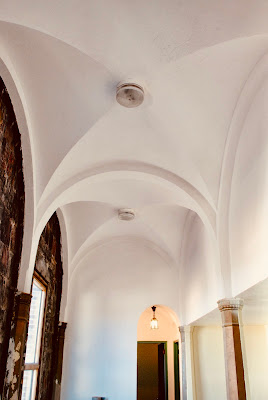 |
| Postcard of the former home of Goodwin Chapter 36 of Royal Arch Masons in New Jersey. |
Haven’t posted a Flashback Friday on The Magpie Mason in a long time, but recently something reminded me of a visit to an unusual building fifteen years ago that I never told you about. The owners of a property, once a Masonic temple, in Manasquan, New Jersey were preparing to sell. In the process, they let it be known that if Masons and their families desired one last look, the doors of 168 Main Street would be open to them for a little while on Saturday, January 9. This was 2010.
With a cornerstone-laying ceremony by the Grand Lodge on Friday, October 12, 1923, this building is unique because it was a Masonic temple without a lodge. Instead it had a Royal Arch chapter!
With commercial space downstairs, the upstairs housed an Egyptian-motif (remember, this is 1923) chapter room with all the architecture necessary for Goodwin Chapter 36 to confer the degrees of Capitular Masonry.
Those were the days. Masonic membership was exploding during the 1920s in a boom that started during World War I and continued into the economic boom times of the twenties. Lodges proliferated, real estate was acquired and developed, the appendant bodies flourished, supply companies thrived in their sales of regalia, furniture, and everything else.
(There was a Craft lodge in Manasquan. Wall 73 was located all of two-tenths of a mile up Main Street at the corner of South Street.)
Goodwin Chapter had been around a long while by the time this building went up. Goodwin was constituted October 2, 1882 during a previous golden age as the Masonic fraternity shook off the injuries of the anti-masonic scare and grew during and after the Civil War. Goodwin 36 is long gone, having amalgamated at some point with Hiram 1, together becoming Goodwin-Hiram Chapter 1 in Toms River.
I have no information on the architect, so I can’t promise you this room has any of the kind of accurate details as are found in Egyptian Hall inside the Masonic Temple in Philadelphia.
Anyway, I shot a few dozen photos during my visit that January day. The chapter room was said to have gone untouched for approximately fifty years. For some reason, everything was painted white at some point, making many of my photos look one dimensional and unimpressive. I had to tinker with some of these to elicit a little detail. Still, I’m glad I got to see this.
Not sure why I never got around to sharing all this until today.
 |
| Probably not the archaeological accuracy of Egyptian Hall in Philly. |
 |
| Guessing there’s a crypt underneath. |
 |
| Grand Chapter proceedings inside a Herring Hall Marvin Safe Co. safe. |
 |
I’m not familiar with this brand. I wonder if it was made
in Trenton with Clear Havana leaf. |

























































































